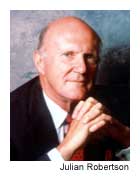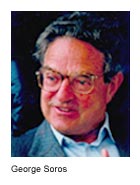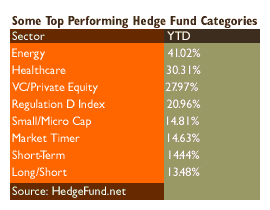|
A hedge fund style falters
|
 |
May 11, 2000: 8:11 a.m. ET
Smaller funds edge out Soros' and Robertson's all-encompassing strategy
By Staff Writer Jennifer Karchmer
|
NEW YORK (CNNfn) - The broad investing style that helped hedge fund behemoths George Soros and Julian Robertson soar to financial heights also contributed to their recent downfalls.
"Macro" funds that invest in a variety of instruments -- including stocks, bonds, commodities, currencies and futures -- are falling out of favor as a new generation of smaller, more focused hedge funds become more dominant.
"Soros was a stock picker, but he's lost his edge. Now with the Internet, everybody has information, so that has challenged the macro player," said Thomas Zucosky, head of marketable alternative investments at Strategic Investment Group in Arlington, Va., at a hedge fund forum in New York earlier this week.
Soros Fund Management, the world's largest hedge fund, recently announced a revamping of the Quantum Fund amid steep losses in technology stocks and the departure of two top managers. Robertson announced in March that he was liquidating his funds and closing the doors on Tiger Management as his bets on value stocks backfired. 
Certainly, technology hurt both managers. Amid stunning losses that rocked the Nasdaq earlier this year, Soros held onto his tech holdings too long, while Robertson shied away from the tech sector altogether.
Macro on the way out
But the downfall of two former stars has raised questions about the health of the hedge fund industry.
Many analysts -- including Zucosky, who attended the 7th annual Hedge Fund Forum in New York May 8 -- say the industry is at a crossroads. Large macro players are getting elbowed out of the way by smaller funds with narrow focuses.
Macro hedge funds were down 2.36 percent in April, according to HedgeFund.net, which tracks the performance of 1,400 hedge funds. Year to date, macro funds are up just 1.37 percent -- compared with all hedge funds as a group, which are up 7.81 percent, HedgeFund.net reports.
Smaller funds thrive
The shakeup at some macro shops shows how difficult it is for managers of huge funds to navigate market waters, analysts agree. Soros, who saw his Quantum Fund drop by about $5 billion recently, manages an estimated $12 billion in hedge fund assets.

As a hedge fund grows in asset size, it may become unwieldy and more difficult to run. In general, funds are going to have their best performance during the early years when the fund manager is ambitious, assets are low and enthusiasm is building for the portfolio, industry experts say.
"The real issue is the size of positions," said Leslie Rahl, president of Capital Market Risk Advisors in New York City. "It's like trying to turn around a gigantic ocean liner."
In addition, because the macro manager has his hand in a variety of markets, his fund performance is dependent upon several factors.
 "The macro manager makes directional bets in the major asset classes, and they need pronounced movements in sectors to be successful -- energy, precious metals, and broad-based movement in equities, commodities, currencies," said Hunt Taylor, an independent hedge fund consultant. "With the exception of the last year in the tech sector, you haven't had it." "The macro manager makes directional bets in the major asset classes, and they need pronounced movements in sectors to be successful -- energy, precious metals, and broad-based movement in equities, commodities, currencies," said Hunt Taylor, an independent hedge fund consultant. "With the exception of the last year in the tech sector, you haven't had it."
But while some macro plays have had a tough go of it lately, other experts say it's just a matter of time before macro comes back into favor.
"It's not a knock on the (global macro) strategy, but like anything, it's cyclical," said Alex Shogren, President and CEO of HedgeFund.net. "We've seen the last of the big mega global macro funds. As a strategy, it's gone through a rough stretch."
Some are succeeding
Still, despite the woes of many large macro players, not all of the funds are hitting a brick wall. Some small macro funds are managing to deliver good returns.
Roy G. Niederhoffer, president R.G. Niederhoffer Capital Management, Inc., who manages a $100 million macro hedge fund, reports his portfolio is up 37 percent year to date as of May 9.

"Just because we're in a down phase doesn't mean it's a down strategy," Niederhoffer said. "However, I think it's a fine time to look at alternative investments in the macro sector."
Click here to learn more about hedge funds
Niederhoffer says much of his fund's success is due to its small size, which makes it more manageable.
"You have to have a more subtle edge today and it can't run $20 billion," Niederhoffer said. "You couldn't move $20 billion in and out of the market in a day and half. We can very often take advantage of the larger funds which need to take a few days to make a move like that."
Other opportunities
As investors' appetite for macro funds falls off, some managers are finding prospects in other sectors.
Weiss, Peck & Greer, for example, in January opened the Opportunistic Fund, a $15 million hedge fund that invests in small-cap value stocks.
Click here for the differences between mutual funds and hedge funds
"The (macro) area isn't dead, but it's been a string of people having some trouble," said Larry Morgenthal, managing director of alternative investments at Weiss, Peck & Greer. "Small-cap has been an unloved, beaten down area. Things had become so cheap we wanted to put capital into exploiting the area."
Morgenthal oversees a total of $1.5 billion in hedge fund assets, including two technology funds, a long/short fund, a merger acquisition fund, and the small-cap value fund.
He has no plans to offer a macro-style hedge fund, since investors aren't demanding it at this time.
"It's not on the drawing board for the near term, but we may look into it later on," he said. 
-- Click here to send email about this story to Staff Writer Jennifer Karchmer.
|
|
|
|
|
 |

|

